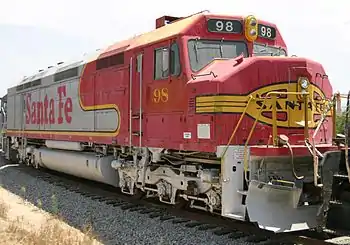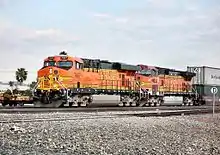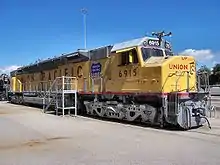Canadian comfort cab
The Canadian comfort cab or wide cab or North American Safety Cab is a broad-nosed cab design found on modern American diesel locomotives, and some export models. It occupies the entire width of the locomotive, and typically has an access door on the front of the nose. The term wide cab is somewhat of a misnomer because it is the nose, not the cab, that is widened.


Development
The basic shape of the Canadian comfort cab first appeared on a hood unit, the EMD DDA40X, in 1969. It was the same design as the F45 and FP45 cowl units being built by EMD at the time. The cab used on the DDA40X was not a true Canadian comfort (or "Safety") cab because it consisted mainly of restyled sheet metal and lacked the structural reinforcements of the Canadian design.[1]
EMD Design
The first true Canadian cabs were designed and built for the Canadian National Railway by input from railway employees. The locomotives were GP38-2s, GP40-2s and GP40-2Ls, and SD40-2s. To denote the presence of the wide-nosed cab, a "W" was often applied at the end of the model name (i.e. GP38-2W, GP40-2W, SD40-2W), although this was not an official designation. The Montreal Locomotive Works also offered a competitive cab design on their M-420 and M-630(W) models. GE and EMD began offering the wide-nose cab as a standard option instead of a custom build option in 1988.
The first Canadian comfort cab appeared in 1973 on CN #5560, the last unit in an order of standard cab-equipped GP38-2s. The first series of comfort cabs were on an order of MLW (Montreal Locomotive Works) M-420s, also built for CN in 1973.
Cab design
The wide-nose cab design has a number of features to improve crew safety and comfort.
Safety
The wide-nose safety cab is built with a specially reinforced nose. Instead of sheet metal, ⅜-inch-thick steel is employed with additional reinforcement behind the armor. As a moving locomotive cannot maneuver to avoid collisions and frequently cannot stop in time to prevent them, these enhancements serve to protect the crew in the event of a collision with objects smaller than the train itself such as downed trees or stopped automobiles. In addition, the windows of the cab meet Federal Railroad Administration Regulations Part 223,[2] which states that windows must withstand the impact of a .22 caliber bullet or a cinder block.
Comfort
The Canadian comfort cab is notably more spacious for the crew. It has significantly more open space than standard cabs, allowing crew members space to move about. In later years, the cab doors had improved weatherstripping and electrically heated windows installed. Many new EMD locomotives include the feature of the "Whisper Cab", a cab that is acoustically isolated from the rest of the locomotive.
References
- CN Locomotive Cab Layout GR-20c, Commission of Inquiry Hinton Train Collision, December 1986.
- Section

